Read this page in your language
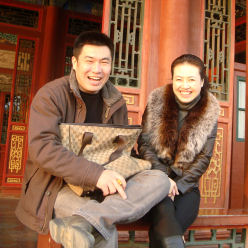
In November 2008, we went to China. This was mostly a business trip: Maggie Guan (who is a director at our company) and I were invited to speak at AdTech Shanghai, a conference for digital marketing. We also went to Beijing to meet with McGraw-Hill China and Tsing Hua University Press, which will publish my book in China. We will adapt the book to China, which means case studies and interviews with Chinese companies, so we met with practically all of the leading Chinese internet companies, including Baidu, Sohu, Sogou, Sina, Net.cn, Taobao, Alibaba, MapBar, and Google China. We had meetings with some 50 people in China. We also had weekends free, so we went to the Great Wall and so on.
As part of the business trip, I wrote white papers and strategy papers for US companies on how to enter the China market. For everyone else, here are my notes on what it's like to travel in China. This has been reviewed and commented by a number of friends in China and I appreciate their help. (I've written about other trips. See my article on India and France.)
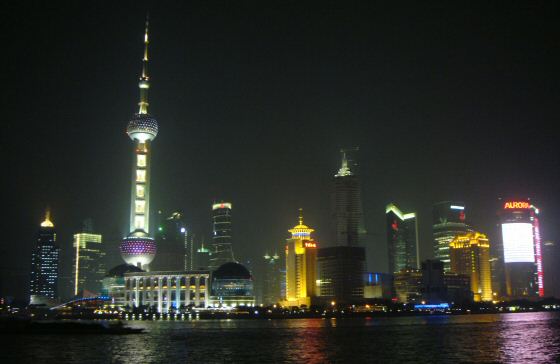
Shanghai
China is often compared to India (and it's usually in the same category as India as one of the BRIC countries) (BRIC = Brazil, Russia, India, China). But this isn't correct: Bangalore is India's center for technology, but Bangalore's airport looks like it was hit by a tornado, and from the airport to the city, old taxis go over chaotic potholed streets.
Shanghai has a modern international airport. You go downtown by a maglev train at 300 km per hour (186 miles an hour). It moves so fast that cars on the freeway appear to be standing still.
That's your first indication China isn't a developing country. The next is when you get out in downtown Shanghai. There are spectacular skyscrapers in all directions. There are over 4,000 skyscrapers (buildings with more than 40 floors), skyscrapers as far as you can see in all four directions, all the way to the horizon.
To me, Shanghai has the best features of Silicon Valley, New York City, and Paris. It has the energy and modernity of Silicon Valley, the skyscrapers of Manhattan, and it is also a very charming city of small streets filled with neighborhood restaurants, cafes, shops, and second floor or third floor apartments, like in Paris.
We stayed at a hostel in downtown Shanghai. The People's Park was nearby, which is beautiful and well-maintained. In the park, there is the Museum of Contemporary Art (MOCA), which has a good collection of Chinese contemporary art on two floors (see the museum at www.MOCAShanghai.org). China's art scene is very active with hundreds of galleries and artists' workspaces. We walked around Taikang Road (highly recommended), which is a maze of hundreds of small shops and art galleries. We also went to 50 Moganshan Road, where an old sugar factory was converted into artist workspaces and galleries. I've never seen so many artists in one area; there is nothing like this in the USA or Germany. We spent hours looking at art and talking with artists. There are cafes where you can get a bowl of noodles and tea.
We also went to Xin Tian Di (the Chinese name means New Heaven and Earth, perhaps because the area used to be an old neighborhood of traditional Shanghai style, today the area still maintains its original building style with a face lift), which is a European-style shopping street, with fashion stores, cafes, wine bars, and restaurants. It's very popular for Chinese because it's different.
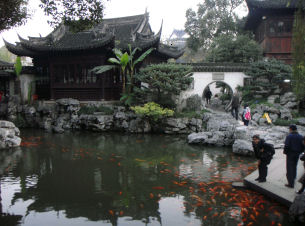
The Yuyuan Garden is a 400-year old compound with houses, temples, tea rooms, pools, and private parks, built by wealthy merchants and imperial officials. There are some 40 pavilions, including some of the most lavish examples of classical Chinese architecture and landscaping. You'll notice doors can be in many shapes: square, round, bottle-shaped, and asymmetrical. In the West, doors are just rectangular. It takes about four hours to see the Yuyuan Garden.
Shanghai's main shopping area is Nanjing Road, which is like the Champs-Elysees in Paris: a broad walking street with large stores and huge neon lights. It is the world's longest shopping boulevard at 6 km long (three miles) with over a million daily visitors. A small street car takes you along for the sights. The best hotels in Shanghai are on Nanjing Road.
Along the river is the Bund, which is another long walking area. Beautiful buildings line the waterfront. We were there at 11 pm at night. Hundreds of street vendors sold all kinds of items, along with lots of food.
You can cross under the river by tunnel. This is a very odd thing. It's like a horizontal elevator. As you go along, there is an illuminated psychedelic light show. It doesn't make any sense, but it's very Chinese: they love bright lights. They also like to mix things up. See a very good example of this at the Shanghai World Financial Center (the second tallest building in the world). Before you go to the top, you go through a multimedia show. It's very hard to describe; it's a mix of 3-D, Disney, fantasy, spinning buildings, winged fish, and helicopter birds. It doesn't mean anything, but it's totally cute.
The time difference works well when you go from California to China; you arrive in Shanghai at 8 pm (in California it's 5 am), so you can go to bed after a 14-hour flight. One night, I turned on the TV. There are 50 channels, including one in English. CCTV is the Chinese TV company (similar to the BBC in the UK).
We went by sleeper train from Shanghai to Beijing. There were no more private compartments, so we took compartment for four. It was 500 yuan ($75) per person. Our cabin mates included a Chinese engineer from HP and an owner of a cashmere sweater factory. It was safe, clean, and quite comfortable, just like trains in Europe. We bought the tickets the day before. In general, Chinese tend to buy tickets or make reservations for hotels, trains, or airplanes at the last moment because there is so much available service.
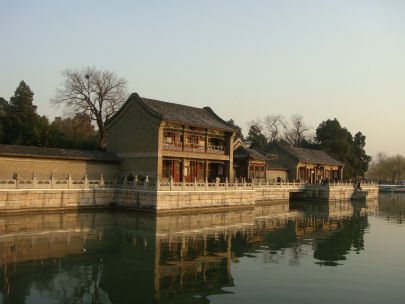
Beijing
Beijing has a different feel from Shanghai. Set on a high plain, there are no rivers or mountains, so it spreads out. You can see skyscrapers all the way to the horizon in every direction. Streets are very long and many of the old buildings are only one or two stories, so it doesn't have the small neighborhood feel of Shanghai. Many parts of the city are like large European or American cities: malls, super stores, shopping centers, and office complexes. Beijing has probably the world's best collection of modern skyscrapers. There are buildings in every possible design, shape, and style, including the Bird's Nest, the Water Cube, and CCTV's building. There are more than 25 million people in Beijing.
We spent a long afternoon in the Forbidden City: 1,000 buildings, 9,000 rooms, 72 acres. Only a third is open to the public, but that's more than enough. It is mostly stone with only a few trees in several courtyards (based on Feng Shui). There are thousands of sculptures, pools, courtyards, and spectacular Chinese rock gardens. You can visit offices, temples, and bedrooms of the emperor, the empress, and his 4,000 concubines.
I preferred the Summer Palace. It is a vast park with lakes, forests, hills, and a number of temples, pagodas, and palaces. I like it because it appears natural, yet the entire thing was man-made. European gardens are in two styles: French gardens and English gardens. The French garden (also called an architectural garden) is a series of points and lines to form strict geometrical patterns. The English garden was copied from classical Chinese gardens, which create a sense of nature.
The Temple of Heaven is a large park of 600-year old imperial temples. The emperor came once a year to perform rituals to ensure a good harvest. Like everything Chinese, it's the world's largest religious temple (1 square mile), although it's not for a specific deity. If China is the middle kingdom and the center of the world, then the temple has a marble disk that is the spiritual center of heaven and China. People crowd around to get a photo of themselves standing at the center of heaven, which brings good luck and blessings. It's also very popular for outings.
As some of you may know, I lived in Europe some 15 years. I visited all the major European palaces. Nothing in Europe comes close to the size and splendor of the Forbidden City, the Summer Palace, or the Temple of Heaven: not Rome, Paris, Versailles, Berlin, or London.
The Black Lakes is several connected lakes just north of the Forbidden City. In summer, there's boating and in winter it freezes over. A walking street rings the lake, with hundreds of cafes, restaurants, shops, night clubs, and street vendors. It's very pleasant to walk along here. Nightclubs are new in China. Chinese tend to socialize in restaurants over lots of food.
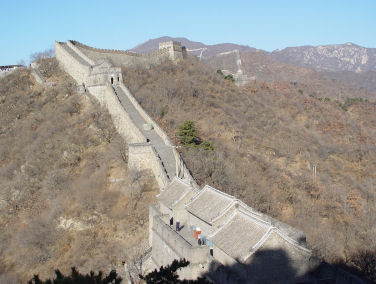
Every book says you must go to the Great Wall, and they're right. Once again, there is nothing like this in Europe. I hiked in Scotland to see Hadrian's Wall, which the Roman Empire built to keep the Celts out of England. But that was just a low wall that ran a mere 70 miles. The Great Wall of China is 4,000 miles long and goes over extremely steep rugged mountains. It is massive: 30 feet high and 16 feet wide at the top. Made of brick, the earliest parts are from 800 BC. The wall in its familiar form started in the 1400s. Over a million soldiers were stationed along the Great Wall. Many parts of the Great Wall have been restored, but much of it is in disrepair: it's just rubble and fairly dangerous to walk on. We went to Mu Tian Yu, about 90 minutes north of Beijing, where chairlifts bring you up where you can start to walk on the Great Wall. Watch towers are spaced an arrow-shot apart. Guide books rarely mention how steep it is. It's a difficult walk. You must wear sturdy walking shoes (hiking boots are better) and be able to walk up very steep inclines for 500 feet or more. It's not for little children or elderly. We walked on the south end, up a very steep mountain ridge. At the top, a sign warned us not to go further. Of course, everyone ignores the sign and continues. The reconstructed part ends and Great Wall soon turns to a dirt path along the top of the wall, with brush and trees growing out of the wall. Soon, it turns into rubble. The views are remarkable. The Wall goes along very steep ridges, up and across the landscape, off into the distance. At a peak, we met several Germans and we all sat and looked out over the landscape. Remember that steep climb? On the return, it became a very steep drop. Instead of taking the chairlift down, you can also go down by toboggan slide. You control the toboggan, so you can go as fast as you dare. It's one of the best rides I've ever been on. That again is very Chinese; they mix things up. Would you expect a fun toboggan ride at the Great Wall?
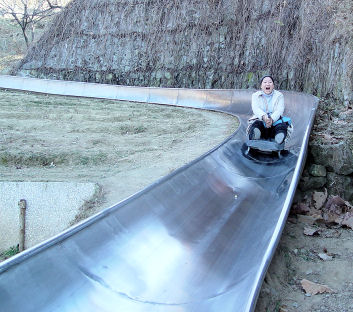
You can go to the Great Wall at various places: Ba Da Ling is easier to walk on, but that also means more crowds. Mu Tian Yu is steep, which means fewer people, but it's also beautiful (and has toboggan rides). Again, there is nothing in Europe like this. No European castle or fortification compares to the vastness of the Great Wall. Although it was early December, the weather was bright and sunny in the low 50s.
Beijing has six city rings. This naturally inspires people to see how fast they can go around the city. Chen Zhen holds the record, who did the second ring in 13 minutes at 150 km/hr (95 mph), which earned him the name "Er Huan 13 Guy" ("13 Minutes on the 2nd Ring Road") (it also got him seven days in prison :-) A motorcyclist did it in eight minutes at 315 km/hr (195 mph). Police set up cameras, barricades, and chase cars, but speeders got through. Thousands of people lined up along the ring road to watch the speeders and the police chase. Live television showed the fun.
We were lucky to hire a private guide in Beijing. This saved us quite a bit of time because she knew where to go and the best things to see. For the trip to the Great Wall, Sunny arranged a driver, so we went in a sedan, comparable to a Lexus. She also knew good restaurants and so on. The entire day was around $140. To contact Sunny, write to huanxingbingyan at hotmail dot com.
In Beijing we also went to the Bird's Nest Stadium and the Water Cube. The plaza can easily hold a million people. At 8:30 pm, both the Water Cube and the Birds Nest are illuminated. Tens of thousands of people were walking around. There were vendors, food, dozens of kites, and a general festival atmosphere.
A few days later, the weather changed and winds came down from Mongolia. The temperature dropped to 16 F, and yes, that's remarkably cold, but we had much business to do, so we added more scarves and kept going.
We also walked around the 798 Art District, also known as Factory 798. This was an old military factory, built by East Germans in Bauhaus style, that again has been taken over by artists and turned into an extensive complex of galleries and workspaces. It can take a full day to see the art galleries. Visit their website at www.798art.org
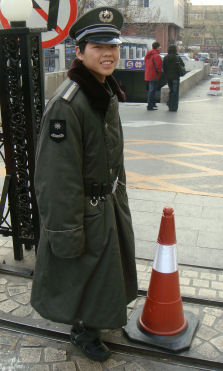
More Things about China
We rarely noticed any police. Near the hostel, there was a police station and I noticed they had police bicycles. In California, the police are always racing around with their sirens. Maybe they should ride bicycles and be more peaceful. The few cops I met were friendly. Street vendors sell this silly kid's toy; it's a rubber nose with a small pipe: you blow on the pipe and two strips of paper fly out from the side of your nose. When we were walking out of the Summer Palace, a policeman was wearing one of these. When you said goodbye, he blew on the nose. He was just goofing off. At the Bird's Nest Stadium, street vendors were selling souvenirs such as key chains. We walked past two cops who yelled out "Souvenirs! Buy Bird's Nest Souvenirs!" They were goofing off and pretending to be street vendors. One of them had found a lost keychain souvenir and was selling it. I smiled and said how much? We negotiated in fun and he finally laughed and said "Here, you can have it."
Almost every building has security guards, but all they had was a uniform and a cap. They mostly just stood around and answered questions, such as directions to restaurants and so on. I also noticed many shops were unattended. The owners were visiting next door or went out to get lunch. They trusted that no one would bother their shops.
Traffic is fairly orderly. It's not the free-for-all chaos of India or Italy. Nobody ran stoplights or drove on the wrong side of the road like in India. The streets are wide and there's usually a separate lane for bicycles. You can catch a taxi within minutes. They always use a meter. Most trips around town were only $1.50-3 (10-20 yuan). There are a few two-person three-wheel taxi cabs. In some places, there were bicycle taxis. The taxi drivers were generally very honest; they never tried to overcharge us, which was quite common in India. One driver got lost so he didn't charge us at all. The streets are also very clean. There is practically no litter. There is also very little graffiti.
You should learn a bit of Chinese. It's not easy to get around in China if you don't speak Chinese. Highway signs are often in both English and Chinese, but subway signs, ticket vending machines, and so on are all in Chinese. Either travel with a Chinese friend or hire a guide. However, it's misleading to say few Chinese speak English. One forgets how many Chinese there are. China has 1.33 billion people, so a few are quite a few. I've read that more Chinese speak English than the number of Americans who speak English. Most of the young people whom I met could speak passable English (their English was better than my Chinese.)
You have to wear good walking shoes. You walk a great deal. Street blocks are often very long. Nearly every building or house has a high ledge you step over to enter. We often went into shops where there was a small stone bridge or beautiful stone paths into the store.
Chinese love pets. Almost every house, shop, restaurant, or hotel has some sort of pet. I think it's part of their general love of nature. Chinese say they have the "four pets": animals, fish, birds, and insects. You see lots of dogs and cats. Although there are often stories in the US that Chinese restaurants steal dogs, I saw many dogs asleep in door entrances. They don't seem to worry. Many shops and practically all restaurants have pools of fish or very large aquariums. The pools are often cut into the floor and filled with large goldfish or koi. I've never seen this in the USA. You also often see bird cages with myna birds, parakeets, or parrots. At night, the birds are brought inside and during the day, the cage is hung outdoors. We also saw a number of cricket cages. There are lots of pet shops. Where pets in the USA are often for kids, it seemed to me pets in China were for the adults.
Kites are also common. At most public places, several people were flying kites. Sometimes, there were dozens and dozens of kites.
China is mostly atheist, so I didn't expect Christmas trees, but there were lots of secular Christmas decorations: Christmas trees, lights, and so on in front of many large department stores. Chinese learn fast about Western holidays; our holidays are really just opportunities to sell and the Chinese like that, so they're picking up our holidays: Valentine's Day, Christmas, Halloween, and so on.
One night, as we were going out for dinner, we looked up and saw the new moon under Jupiter and Venus. They were aligned to form a smiley face in the sky. We pointed it out to people and many others had already noticed it. This was visible that night from Australia to China.
China seems to be run by kids (which is literally true since most families have only one child who is at the center of family's attention). Everyone is young. Most of the people who run hotels, restaurants, and shops are women. In fact, they're mostly young women in their early 20s.
China has limited energy resources so there are solar water heaters on top of many houses. Along the road, many of the lights and electronic equipment had solar cells. Another way to save energy is to dry clothes outside. You see clotheslines everywhere, including balconies of tall buildings, in the trees, along the streets, and so on.
I took two cameras: a large Sony digital that looks like a 35-mm camera and a small pocket camera. Both were 5 megapixel cameras. Maggie and I often took photos of the same scene: the large camera produced much better quality. However, the small camera was more useful. A single chip held 2,500 photos, which was enough for the trip (we took about 1,800 photos, of which 180 were the best.) It's a good idea to bring your camera's USB cable so you can copy your photos at night onto the laptop.
I was warned by a number of Chinese friends to bring toilet paper to China. It's true: the toilets rarely have toilet paper. But you can find toilet paper in every supermarket, so you don't have to bring your own rolls. There were two types of toilets; in the countryside, there were squat toilets. In the city, the toilets generally had two-button flush to save water; one button released a small amount of water, the large button released a full flush. I've only seen that in one toilet in the USA.
Napkins are also an issue. If a restaurant has napkins at all, then these are tiny thin sheets. I was glad I brought large napkins. You can use these for many things.
In the hotel rooms, there was always an electric kettle so you could boil water. This was very useful; the air in Beijing is very dry, so you drink lots of water. If you fill the kettle, boil the water, and let it cool, you have plenty of drinking water. We always drank bottled water (the tap water isn't safe for drinking.)
We had WiFi or cellular connection practically everywhere. The only exception was at the Great Wall, where the mountainous landscape was too rugged and empty for that. Although my gPhone was able to use the Chinese cell system, I didn't use it because I would have gotten too many phone calls at 3 am. SMS text messaging was good enough for me.
In streets with lots of foot traffic, there were cart vendors who sold food, drinks, cigarettes, and so on. Some of these were very clever; people had a small grill on the back of their bicycle. In one small street, cart vendors had a hot pot where you could get skewers with various items. These were 1 yuan (15 cents) each.
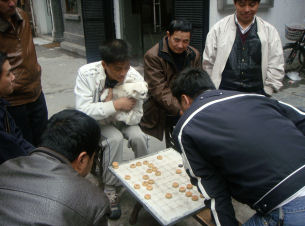
We also visited people in their homes. We had dinner at the home of a CEO of a small company that produced and sold medical devices worldwide, incl. South America and Africa. They lived in a large gated community as modern as Germany or California, with swimming pools, parks, walking paths, shops, coffee houses, and so on. His four-story townhouse was around $400,000 with multiple bedrooms, bathrooms, and office space. His family also had a private cook who made a large dinner for everyone. There were SUVs or sedans parked in front of most of the houses. China is often presented as a developing country, and many people still live in rural areas and small villages, but there is also a China just as developed as the best parts of the USA or Europe. In only ten years, China's economic development lifted 600 million people out of rural poverty. No other country has done similar.
Every Western brand is in China. They want to be part of the massive Chinese market. We saw all the major stores, brands, and banks. There are also brands which are somewhat out of fashion in the USA, such as Holiday Inn and Dairy Queen. Lots of Subway sandwich shops, along with Hooters and Outback. There are also Playboy shops in the malls, but these have nothing to do with the girls. They sell lifestyle items, such as jackets, shirts, pants, and shoes. It's just a clothing brand in China. I also saw a clothing store called "Valued Squirrel". It's a nonsense name for a store, but probably a Chinese who spoke poor English selected that. We often saw misspellings or awkward English sentences on signs. The same thing happens in the USA. When you see those T-shirt or bags with Chinese characters on them, they were often created by someone who can't read Chinese, so it's nonsense text. This happened a few months ago to the Max Planck Institute, a major German scientific research foundation. For the cover of their monthly academic journal, they wanted to put some Chinese characters. They found what appeared to be an old poem and it looked nice. They even had it reviewed by a German professor of Chinese. Well, too bad for Herr Professor! The poem turned out to be an advertising poster for a bordello, promising "hot ladies with sexy bodies!" So the next time you want that handbag with Chinese characters on it, maybe first find out what it says.
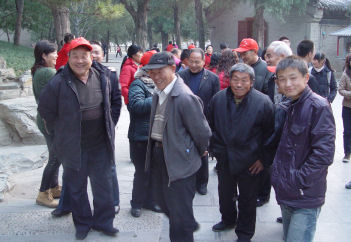
All the Food in China
Okay, let's talk about the really good stuff in China. Chinese say they have only two gods: money and food. China is a great place for food. Every day, we went to a different restaurant or place for breakfast, lunch, and dinner, plus various snacks in-between. American business is generally a one-hour meeting where everyone stays focused on an agenda. Chinese meetings are often two or three hours and much of the time you talk about all sorts of things, and then everyone goes to a two or three-hour lunch or dinner. Americans are capitalists, so each one sits in front of his private plate. Chinese are social collective communists, so the dishes are placed in the center and everyone shares. You try a little of this and a little of that. But you can't go hungry; Chinese love to order way too much food, most of which you've never seen before and it's all delicious. Another very Chinese habit: they add things to your plate as you're eating. You simply can't go hungry in China.
As many of you know, Chinese restaurants in the USA aren't Chinese. "Broccoli with Beef" doesn't exist in China. There are no fortune cookies in China. This is only-in-America. If you want to go to a real Chinese restaurant, ask born-in-mainland-Chinese and tell them you want real Chinese food. In Silicon Valley; there are several hundred thousand Chinese here, so there are great Chinese-restaurants-for-the-Chinese (the restaurants in San Francisco's Chinatown are mostly for tourists.)
Guess what? There aren't standard Chinese restaurants in China either. The restaurants and cuisines are very different from each other. If you say "French restaurant" or "Mexican restaurant", you know what to expect. But in China, I had no idea what each restaurant would offer. Every meal was so different from the other.
Chinese cuisine rarely (well, never) presents one thing by itself (for example, in the USA, a steak is cooked by itself and served by itself. A Chinese dish is always a combination with two or three items with several spices, for example, green beans with noodles and garlic in a sauce. To Chinese, our Western food is very boring. I also noticed most restaurants don't serve rice. You have to ask for it. We somehow assume all Chinese eat rice, but they don't.
Another custom (or lack of custom) is liquid with the meal. Generally, they may have tea after eating. There aren't glasses of water on the table. Some people drink a Coke or beer or water, but only a few. Chinese beer was quite good. We also had red wine at several places. Mostly, we drank water or tea. Starbucks had a big influence on tea in China; when Chinese saw that coffee could sell at high prices, they increased the price of tea.
There are many more things than we have in the USA. One place served hot corn juice. Take fresh corn, squeeze it, warm up the juice, and serve. Chinese also shred potatoes into thin strips, as thin as noodles, and serve this as a salad with other things. It's actually quite good. Potatoes are a standard in Western food, yet nobody seems to have come up with this way of preparing potatoes. Another place served breaded and fried corn kernels. Whoa! Really delicious. Wait until American fast food discovers this.
Most Chinese meals include soup. There is soup with cabbage, meat, vegetables, or dumplings. There are soups with tiny crabs. There is also hot pot (which can also be found in Silicon Valley). It's a pot on top of a burner that goes on the table. You get a large assortment of raw meats and fresh vegetables; when the broth is boiling, you add a few items. When it starts to boil again, you can pick out the items and eat them, and add new fresh items. In Shanghai, we went to a hot pot restaurant that featured all kinds of mushrooms. Along with hot pot, you make a small bowl of sauce. At a spice table, you select from 30 or 40 different spices, add them to your bowl, and stir it up. In general, Chinese eat much more vegetables than Americans, although I wouldn't say they are vegetarians. Cabbage was served in many forms that we don't have in the USA. They also have many kinds of stews with vegetables and meat.
And there are all the things we don't eat, such as seahorse (I didn't even know you could eat seahorses). These are deep-fried on a stick. You can also get scorpions, star fish, sea urchin, sea cucumber, and insect larvae, also deep fried on a stick. At several outdoor stands, there were tiny BBQed sparrows. I had a few; you eat the whole thing, beak and all. It's crunchy and tastes fine. We were driving along in the countryside and I saw a donkey pulling a cart, so we talked about that. The Chinese then took us to a restaurant that served donkey and ordered a dish for me. It also served dog, so they ordered that as well. If you didn't know it was dog or donkey, you wouldn't notice anything. It's mostly North Chinese restaurants or Korean restaurants that serve dog. We also had 1,000-year-old duck eggs, which taste delicious, somewhat like blue cheese. The eggs are packed in a spice mix of black tea, wood ash, lime, and salt and stored for several months.
Many food stands serve grilled squid, also on a stick. At very small shops, you can get steam buns, stuffed with various things such as spinach, cabbage, and so on. These are great for breakfast. Get a small sack of these and sit in a park. There are lots and lots of noodle shops. You also see sidewalk vendors selling fried noodles late at night. We often ate breakfast at a sidewalk vendor: you get a omelet with ham and cheese, wrapped in paper, and you eat as you walk.
Compared to Americans, Chinese don't eat as many sweets. There is no dessert after dinner. Ice cream isn't as sweet (which tastes better). Coca-cola is also less sweet. They have lots of candy, just less sweet. One thing I really liked was a stick with candied fruit (sugar-glazed fruits), stuffed with walnuts, and wrapped in edible rice paper.
You see all the Western food chains in China: Starbucks, McDonalds, Burger King, Haagen Daz, Pizza Hut, Outback, Dairy Queen, Taco Bell, Subway, Kentucky Fried Chicken (KFC), and many more. KFC is wildly popular. The Chinese call it "Keng De Ji", which sounds like Kenducky. There are mini-McDonalds in small kiosks. And I saw a McDonald's delivery bicycle. It's very likely that someone could live in Beijing and never eat Chinese food (which would be odd, but I suppose it's possible, just as Chinese can live in Silicon Valley and only eat Chinese food.) You see just about every type of food in Shanghai and Beijing. There are Italian restaurants, French, German, Swedish, Persian, Arabic, and so on. We went to a meeting in Beijing that was held in a Mexican restaurant. The Mexican food was quite okay.
In Beijing, we ended a business meeting with lunch at Quan Ju De, which is famous as the best restaurant for Peking Duck. The roast duck was presented to the table and then taken away to be prepared into 105 pieces. The dishes included duck liver, the duck's head, duck soup, slices of duck with small pancakes, and many more dishes. We also got the duck's diploma, which included his serial number (#1.15C98420) Peking Duck started as an imperial dish in 1200 AD, so it's a very elaborate item. Quan Ju De has been serving Peking Duck since 1864. Chou En Lai brought President Nixon and Henry Kissinger to Quan Ju De. Okay, so Peking was renamed Beijing, so why is it still called Peking Duck, not Beijing Duck?
Shopping in China
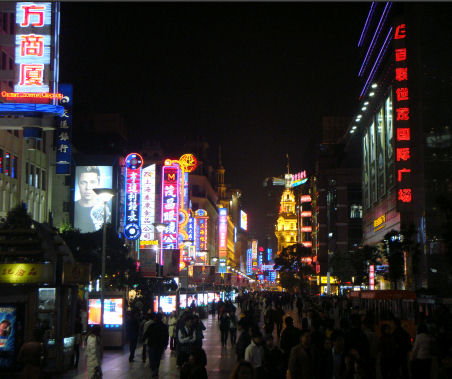
China is a shopper's dream. Every global brand (Dior, Lancôme, Cartier, Coach, Tiffany's, etc.) is there, along with many Chinese brands we don't know. Large stores have hundreds of booths, each selling hundreds of items we don't see in the US. One of the most famous is Silk Street Market, a multi-story building in Beijing filled with hundreds of small shops and packed with shoppers.
American companies complain about counterfeit brands in US Chinatowns. They're lucky Chinese aren't yet selling Chinese brands in the USA. We walked through several large department stores; they have hundreds and hundreds of handbag designs, as good as top Western brands at Chinese prices, such as $35-75 for handbags that would cost $500-900 in California.
Most people wear "global style"; that's baseball caps, fleece jackets, jeans or slacks, and running shoes (Nike, Puma, etc.). The fashion this winter is knee-high boots for women, usually with high heels. Nearly every woman wore tall boots.
You can get just about everything you want at supermarkets. Drugstore items (aspirin, etc.) are in the pharmacies.
Where to Stay
Normally, I stay at hotels, but Maggie said Chinese hostels are good, so we tried those. There are many hostels in the major cities. It's around $10 in a dorm room with 6-8 backpackers or $30-40 for a private room, which is the same quality as a hotel room. This is much cheaper than hotels ($100-300 per night). We stayed in the private rooms.
Hostels have large living room areas with sofas and TV, so you can meet and talk with other people, mostly European and Chinese backpackers. The hostels are clean and safe; you can leave your laptops, cameras, and so on in your room. All of the hostels have free Wifi throughout the building and they generally have free computers where you can check email, etc. They also serve lunch and dinner anytime. There is also a very good breakfast for $3.
We stayed at the Mingtown Hostel in Shanghai, which is in a renovated old house. It's behind the Marriott tower. In Beijing, we stayed at the Peking International Youth Hostel, a few blocks from the Forbidden City. It's in an old Chinese house with an open courtyard, built during the last dynasty. Both places were very charming. The staff was friendly and spoke good English.
To find hostels, visit Hostels.com. I recommend you make reservations. But don't worry if you don't have a reservation: there are thousands of hotels in both cities. Over 100 million people visit Beijing every year.
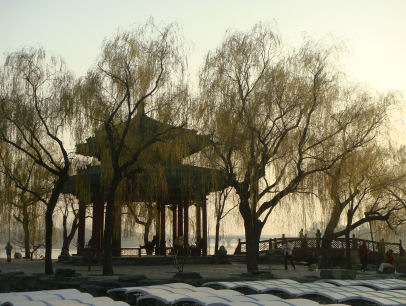
More about China
Going to China is like traveling in northern Europe: easy, safe, and comfortable. There are business opportunities, even with the economic slowdown. China has been growing at 12-15% per year; it will slow down to 8%, but that is more than the US (which shrank 6% last year and will shrink more in 2009). Every company we met was interested in collaborating on projects. We will continue to work with China and I expect to go there several times a year for the foreseeable future.
I saw only a very narrow slice of China. Visitors don't see the vast majority of people. Yet the China I saw was not what I expected. The US government and media talk about an authoritarian Communist regime and make it sound like an improvised, backwards country. What you see is a country that in some areas is equal to the USA and in some ways, is ahead of the USA. I strongly encourage you to visit China and see for yourself.
As I said, we took about 1,800 photos. Of those, 170 are the best ones, which show you what China is like. Send me an email and I'll send these to you.
